1997 CHEVROLET TAHOE brake
[x] Cancel search: brakePage 98 of 433
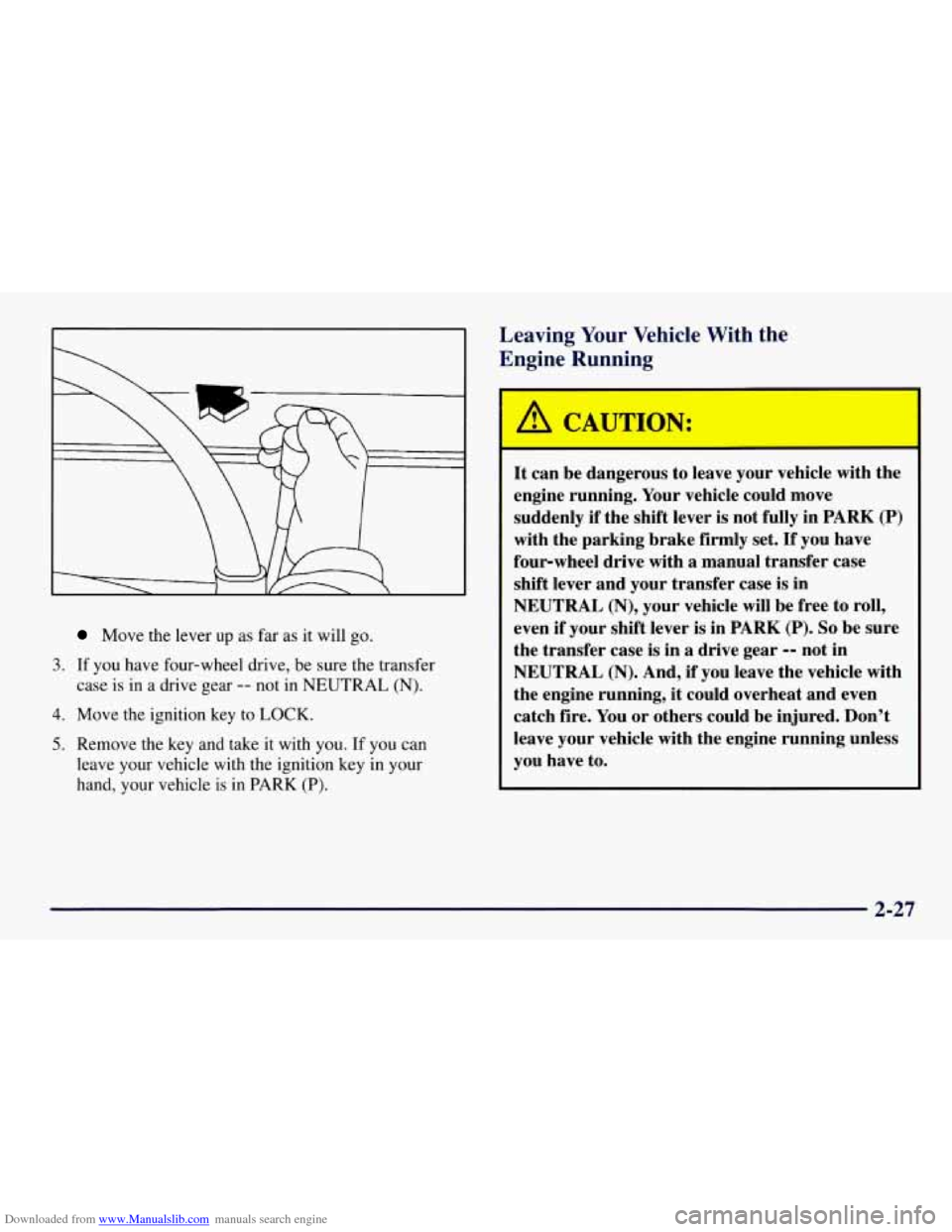
Downloaded from www.Manualslib.com manuals search engine Move the lever up as far as it will go.
3. If you have four-wheel drive, be sure the transfer
case is in
a drive gear -- not in NEUTRAL (N).
4. Move the ignition key to LOCK.
5. Remove the key and take it with you. If you can
leave your vehicle with the ignition key in your
hand, your vehicle is in PARK (P).
Leaving Your Vehicle With the
Engine Running
It can be dangerous to leave your vehicle with the
engine running. Your vehicle could move
suddenly if the shift lever is not fully in PARK
(P)
with the parking brake firmly set. If you have
four-wheel drive with
a manual transfer case
shift lever and your transfer case is in
NEUTRAL (N), your vehicle will be free to roll,
even if your shift lever is in PARK
(P). So be sure
the transfer case is in a drive gear
-- not in
NEUTRAL (N). And, if you leave the vehicle with
the engine running, it could overheat and even
catch fire. You or others could be injured. Don’t
leave your vehicle with the engine running unless
you have to.
2-27
Page 99 of 433

Downloaded from www.Manualslib.com manuals search engine Torque Lock
If you are parking on a hill and you don’t shift your
transmission into PARK (P) properly, the weight of the
vehicle may put too much force on the parking pawl in
the transmission. You may find
it difficult to pull the
shift lever out
of PARK (P). This is called “torque lock.”
To prevent torque lock, set the parking brake and then
shift into PARK (P) properly before you leave the
driver’s seat. To find out how, see “Shifting Into
PARK
(P)” in the Index.
When you
are ready to drive, move the shift lever out of
PARK
(P) before you release the parking brake.
If torque lock does occur, you may need to have another
vehicle push yours a little uphill to take some of the
pressure from the parking pawl in the transmission,
so
you can pull the shift lever out of PARK (P).
Shifting Out of PARK (P)
Your vehicle has a brake-transmission shift interlock
system. You have
to fully apply your regular brakes
before you can shift from PARK (P) when the ignition
is in RUN. See “Automatic Transmission” in the Index.
If you cannot shift out of PARK (P), ease pressure on
the shift lever and push the shift lever all the way up
into PARK (P) as you maintain brake application. Then,
move the shift lever into the gear you want.
If you ever hold the brake pedal down but still can’t
shift out
of PARK (P), try this:
1. Turn the key to OFF.
2. Apply and hold the brake until the end of Step 4.
3. Shift the vehicle to NEUTRAL (N).
4. Start the vehicle and then shift to the drive gear
you want.
5. Have the brake-transmission shift interlock system
fixed as soon as you can.
2-28
Page 101 of 433

Downloaded from www.Manualslib.com manuals search engine Running Your Engine While
You’re Parked
It’s better not to park with the engine running. But if
ever have to, here are some things to
know.
Idling the engine with the air system control off
could allow dangerous exhaust into your vehicle
(see the earlier Caution under “Engine Exhaust”).
Also, idling in a closed-in place can let deadly
carbon monoxide (CO) into your vehicle even if
the fan switch is
at the highest setting. One place
this can happen is
a garage. Exhaust -- with
CO
-- can come in easily. NEVER park in a
garage with the engine running.
Another closed-in place can be
a blizzard. (See
“Blizzard” in the Index.) It
can be dangerous to get out of your vehicle if
the shift lever is not fully in PARK
(P) with the
parking brake firmly set. Your vehicle can roll.
Don’t leave your vehicle when the engine is
running unless you have to.
If you’ve left the
engine running, the vehicle can move suddenly.
You or others could be injured.
,To be sure your
vehicle won’t move, even when you’re on fairly
level ground, always set your parking brake and
move the shift lever to PARK
(P).
If you have four-wheel drive and your transfer case is in
NEUTRAL
(N), your vehicle will be free to roll, even if
your shift lever is in PARK (P). So, be sure the transfer
case
is in a drive gear -- not in NEUTRAL (N). Always
set your parking brake. Follow the proper steps to be
sure your vehicle won’t move. See “Shifting Into
PARK (P)” in the Index.
If you’re pulling a trailer, see “Towing a Trailer” in
the Index.
2-30
Page 108 of 433
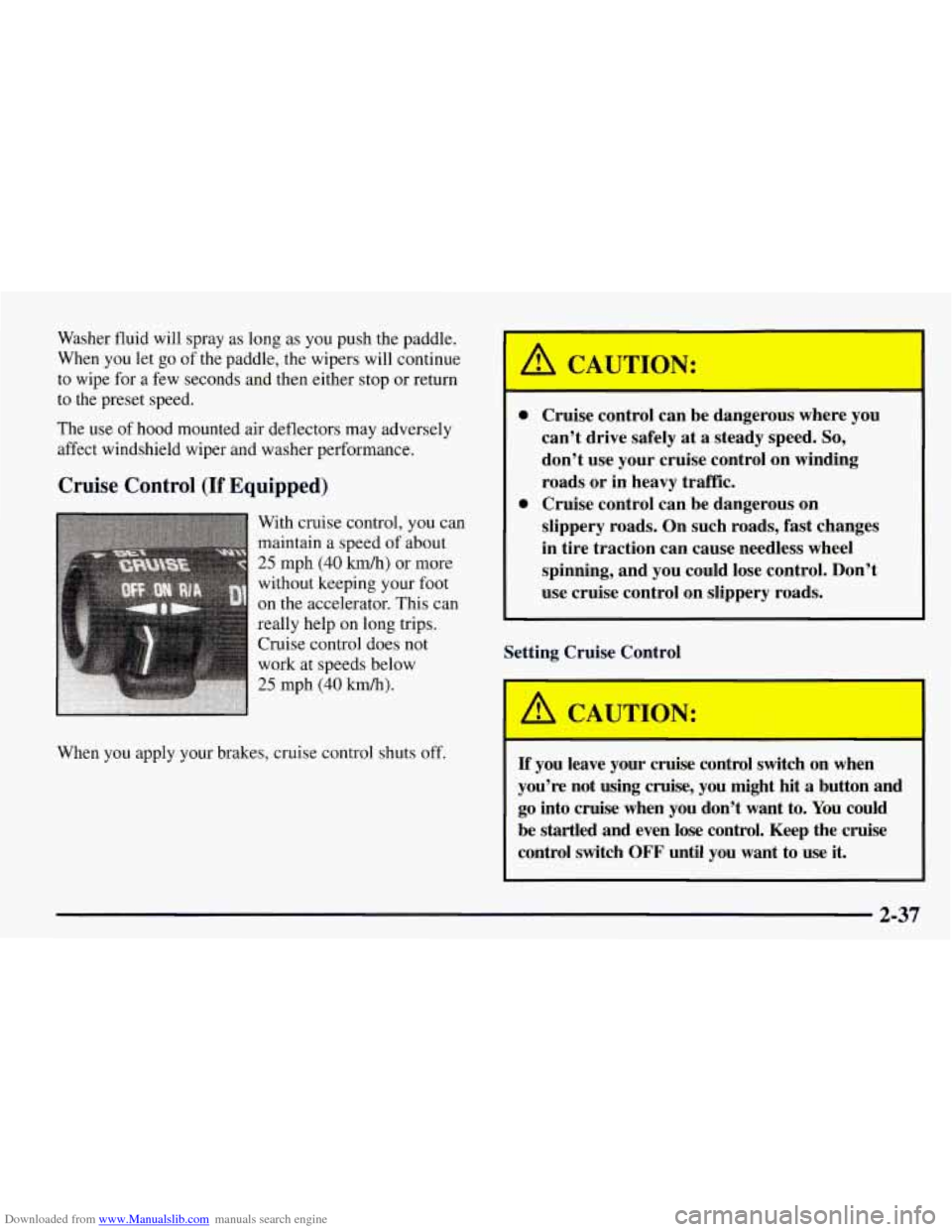
Downloaded from www.Manualslib.com manuals search engine Washer fluid will spray as long as you push the paddle.
When you let
go of the paddle, the wipers will continue
to wipe for a few seconds and then either stop or return
to the preset speed.
The use of hood mounted air deflectors may adversely
affect windshield wiper and washer performance.
Cruise Control (If Equipped)
When you apply your brakes, cruise control shuts off.
0 Cruise control can be dangerous where you
can’t drive safely at a steady speed.
So,
don’t use your cruise control on winding
roads or in heavy traffic.
slippery roads. On such roads, fast changes
in tire traction can cause needless wheel
spinning, and you could lose control. Don’t
use cruise control on slippery roads.
0 Cruise control can be dangerous on
Setting Cruise Control
-
If you leave your cruise control switch on when
you’re not using cruise, you might hit
a button and
go into cruise when you don’t want to. You could
be startled and even lose control. Keep the cruise
control switch
OFF until you want to use it.
I I
2-37
Page 109 of 433
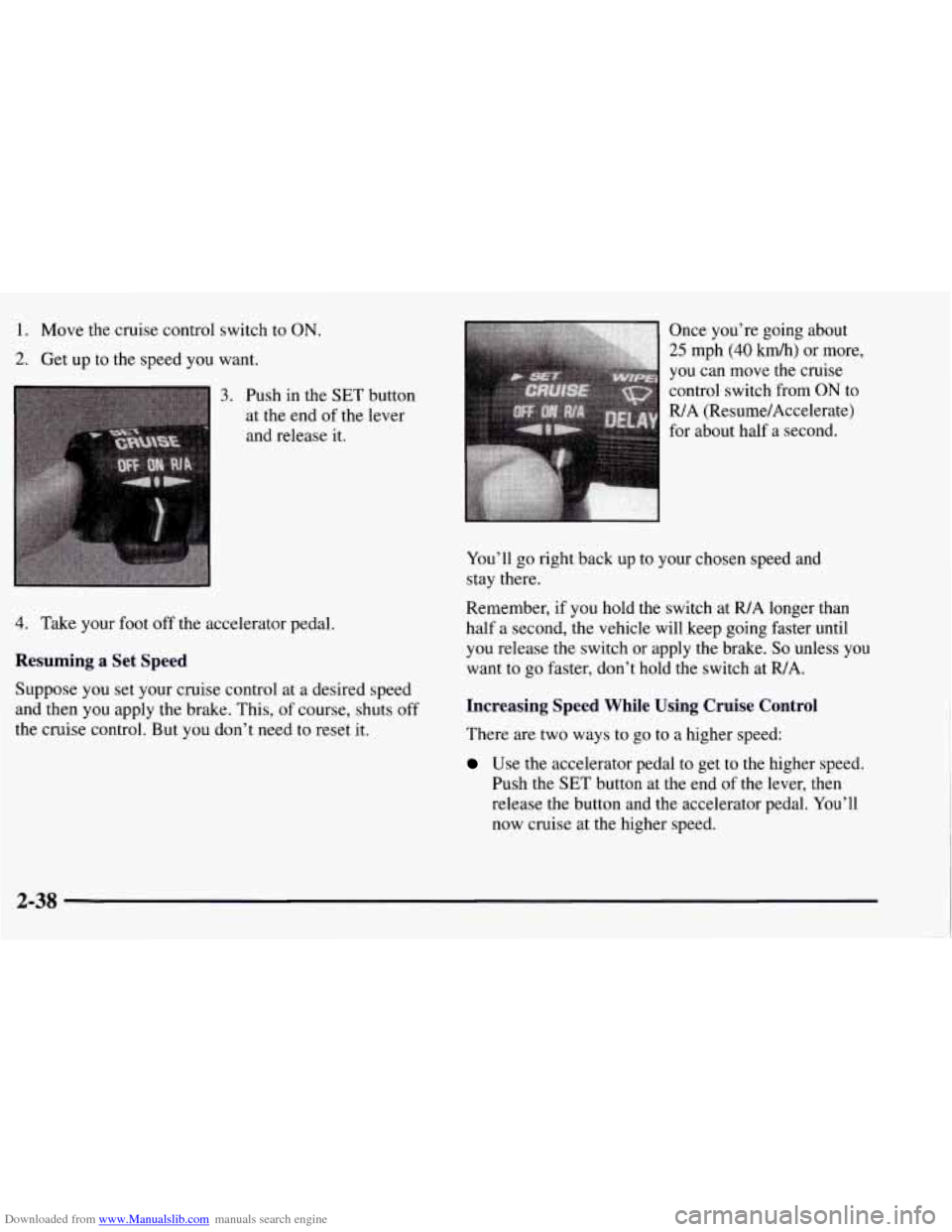
Downloaded from www.Manualslib.com manuals search engine 1. Move the cruise control switch to ON.
2. Get up to the speed you want.
3. Push in the SET button
at the end
of the lever
and release
it.
4. Take your foot off the accelerator pedal.
Resuming a Set Speed
Suppose you set your cruise control at a desired speed
and then you apply the brake. This,
of course, shuts off
the cruise control. But you don’t need to reset it. Once you’re going
about
25 mph (40 km/h) or more,
you can move the cruise
control switch from
ON to
R/A (Resume/Accelerate)
for about half a second.
You’ll go right back up to your chosen speed and
stay there.
Remember,
if you hold the switch at R/A longer than
half a second, the vehicle will keep going faster until
you release the switch or apply the brake.
So unless you
want to go faster, don’t hold the switch at
R/A.
Increasing Speed While Using Cruise Control
There are two ways to go to a higher speed:
Use the accelerator pedal to get to the higher speed.
Push the SET button at the end of the lever,
then
release the button and the accelerator pedal. You’ll
now cruise at the higher speed.
2-38
Page 110 of 433
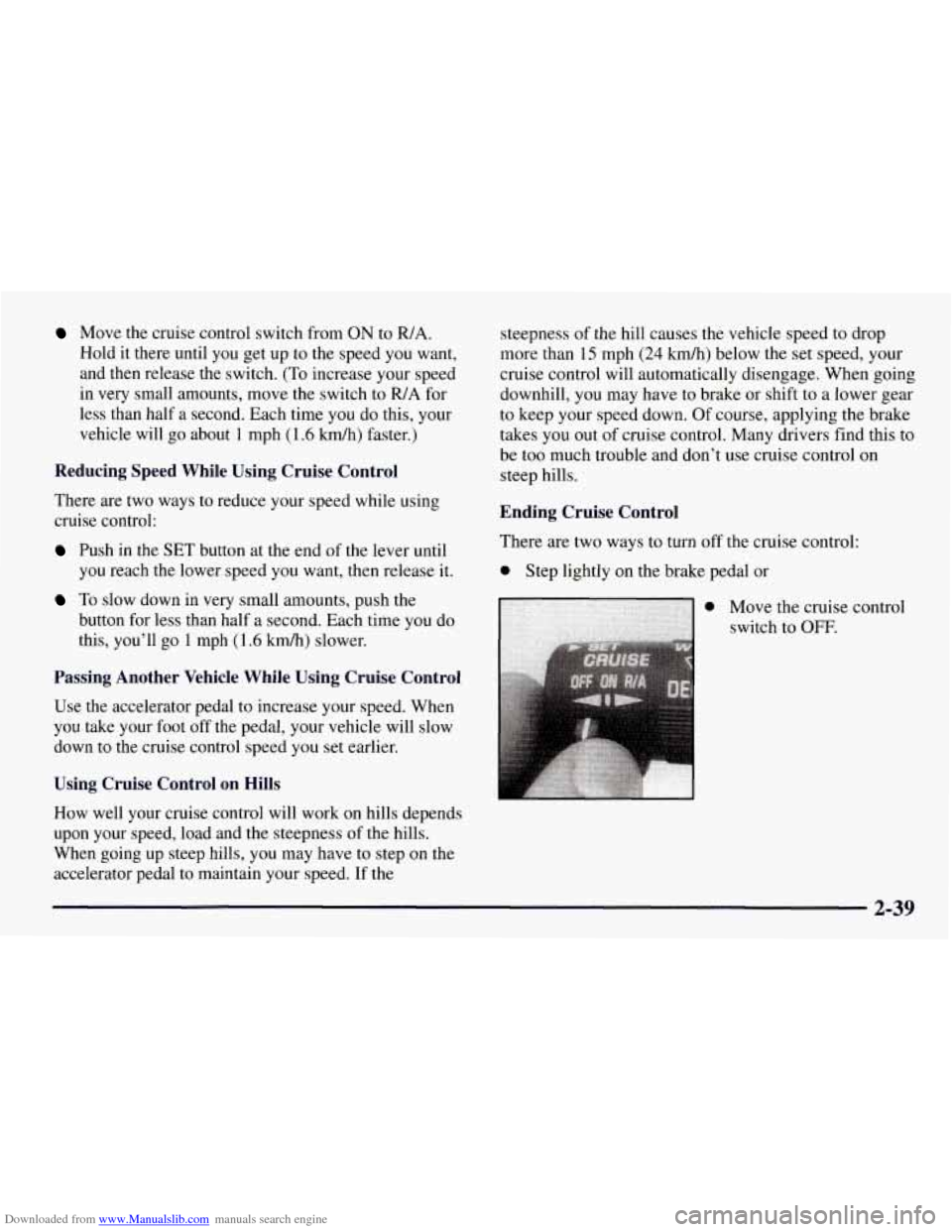
Downloaded from www.Manualslib.com manuals search engine Move the cruise control switch from ON to R/A.
Hold it there until you get up to the speed you want,
and then release the switch. (To increase your speed
in very small amounts, move the switch to
R/A for
less than half a second. Each time you do this, your
vehicle will go about 1 mph (1.6
km/h) faster.)
Reducing Speed While Using Cruise Control
There are two ways to reduce your speed while using
cruise control:
Push in the SET button at the end of the lever until
you reach the lower speed
you want, then release it.
To slow down in very small amounts, push the
button for less than half a second. Each time you do
this, you’ll
go 1 mph (1.6 kmk) slower.
Passing Another Vehicle While Using Cruise Control
Use the accelerator pedal to increase your speed. When
you take your foot off the pedal, your vehicle will slow
down to the cruise control speed you set earlier.
Using Cruise Control on Hills
How well your cruise control will work on hills depends
upon your speed, load and the steepness
of the hills.
When going up steep hills, you may have to step on the
accelerator pedal to maintain your speed.
If the steepness
of the hill causes the vehicle speed
to drop
more than 15 mph
(24 kdh) below the set speed, your
cruise control will automatically disengage. When going
downhill, you may have to brake or shift to a lower gear
to keep your speed down. Of course, applying the brake
takes you out of cruise control. Many drivers find this to
be too much trouble and don’t use cruise control
on
steep hills.
Ending Cruise Control
There are two ways to turn off the cruise control:
0 Step lightly on the brake pedal or
0 Move the cruise control
switch to
OFF.
2-39
Page 112 of 433
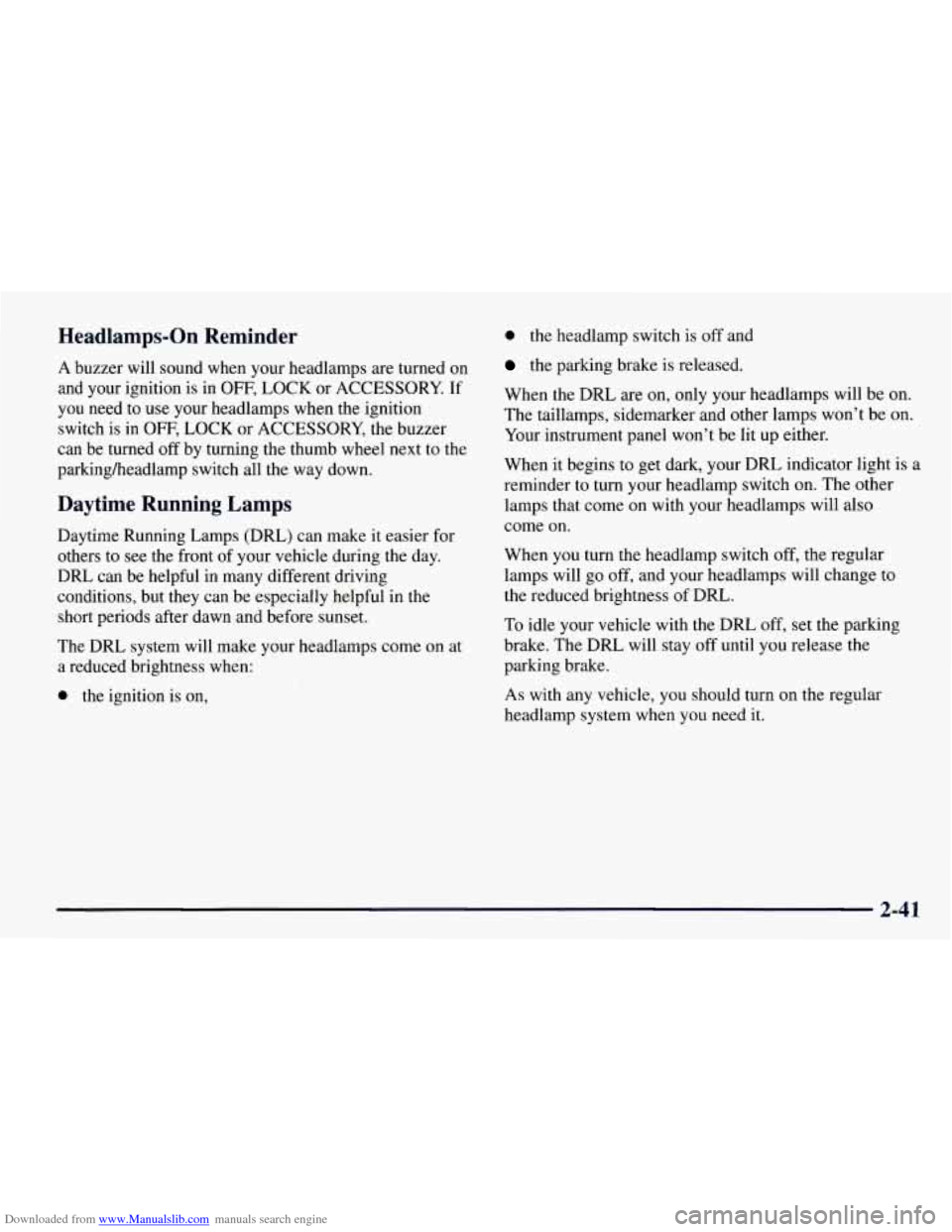
Downloaded from www.Manualslib.com manuals search engine Headlamps-On Reminder
A buzzer will sound when your headlamps are turned on
and your ignition is
in OFF, LOCK or ACCESSORY. If
you need to use your headlamps when the ignition
switch is in
OFF, LOCK or ACCESSORY, the buzzer
can be turned off by turning the thumb wheel next to the
parkingheadlamp switch all the way down.
Daytime Running Lamps
Daytime Running Lamps (DRL) can make it easier for
others to see the front of your vehicle during the day.
DRL can be helpful in many different driving
conditions, but they can be especially helpful
in the
short periods after dawn and before sunset.
The DRL system will make your headlamps come on at
a reduced brightness when:
0 the ignition is on,
0 the headlamp switch is off and
the parking brake is released.
When the DRL are on, only your headlamps will be on.
The taillamps, sidemarker and other lamps won’t be on.
Your instrument panel won’t be lit up either.
When it begins to get dark, your DRL indicator light is a
reminder to turn your headlamp switch on. The other
lamps that come on with your headlamps will also
come
on.
When you turn the headlamp switch off, the regular
lamps will go off, and your headlamps will change to
the reduced brightness
of DRL.
To idle your vehicle with the DRL off, set the parking
brake. The DRL will stay off until you release the
parking brake.
As with any vehicle, you should turn on the regular
headlamp system when you need
it.
2-41
Page 132 of 433

Downloaded from www.Manualslib.com manuals search engine A. Dome Lamp Switch
B. Lamp Controls
C. Air Outlets
D. Multifunction Lever
E. Instrument Cluster
F. Gearshift Lever
G. Audio System
H. Comfort Control System
I. Glove Box
J. Supplemental Inflatable Restraint (Air Bag)
K. Ashtray
L. Cupholder
M. Auxiliary Power Outlets
N. Storage Area or Compact Disc Player (If Equipped)
0. Rear Window Defogger Switch (If Equipped)
P. Tilt Lever (If Equipped)
Q. Parking Brake Release
R. Hood Release
S. Fuse Block
2-61